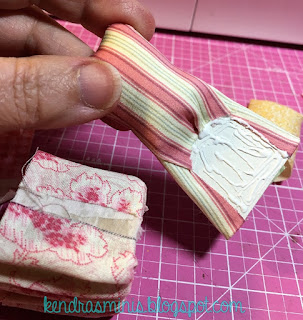1/144 Scale dollhouse, “Patricia House” and Book Review, Mott Miniature Workshop Manual
This 1/144 scale dollhouse was a project found in the Mott’s Miniature Manual. It isn't open in the back, and there are no furnishings, very simple and fit the need I had for being viewable from both sides of the window.
A little about the Mott Miniature Workshop Manual. I recommend this book for anyone who likes to build and wants to learn a lot of techniques. It is a wonderful old book chock full of awesome, unique scratch-built furniture projects. My copy was published in 1978 but I know there are newer versions out there. There are no photos of finished projects, except for those on the cover but there are very nice diagrams and patterns along with instructions and nicely printed brightly colored graphics for decoupaging several of the pieces. Some projects are more involved and require some un-common woodworking techniques (such as lathe-turning and scratch made cabriole legs). Among the projects is a French Harpsichord (with strings and lovely graphics to decoupage). If you happen to find a copy, make sure all of the graphics at the end of the book are un-cut. I photo-copied the graphic for the little dollhouse so I wouldn’t have to cut it out of my book.
The little dollhouse is called “Patricia House”. Instructions start on page 193 and the graphics for it are all found at the end of the book. Most parts are cut out of 1/16th inch thick basswood to which the graphics are applied. I left off the 'tower' on the left side so it would fit on the window sill (see diagram below):
I will warn you that I had to read through the instructions a few times and mark the pattern pieces so I could understand it. There were more little pieces than I anticipated. Here is what the original graphic looks like in the book (section marked “10-B” in photo).
I modified the dollhouse to be shallower to fit in the window sill (photo below, I used only the narrow portion of the side pieces). I also eliminated the “tower” section (since it was too wide) and the porch posts since the back of the love seat would interfere with them.
For my final step, I added some gold highlights with a fine paint pen to the scrolly sections of the dormer and door and window frames. I think it turned out kind of cute, something like those old Bliss litho type houses.
A Little Bit About the Other Items in this side of the dome:
Settee / Love Seat – this was made in a workshop taught by Jeffrey Steele back in (eighties?).
Draperies, shelf niche cutouts – see links to my January (shelf niche) and April 2018 (draperies) blogs.
Dolls on shelves – Three of the four are by Angel Children. The one with the little bed was a recent show purchase by Almundena Gonzalez.
Dolls on sofa – three on the left were estate purchases with no known artisan. The knitted doll is actually a topsy-turvy doll, one that turns inside out with a different character inside and was made by Helen Palenski. The pink sock monkey was by a dear friend, Janice Shaw, with whom I recently was a member of a swap club.
Doll on floor under sofa in a crocheted basket – purse was by my bestie, Karen Haggard.
The little teacups are Chrysnbon, painted by me (maybe a future tutorial??).
Next blog – hmmm.. I want to start another multi-installment project but maybe something short and quick in-between would be best? Here are some options for the next blog. I will see if I get any comments that suggest which should be next:
- Skirted party table
- Mini-kitchen
- Teacup Pincushion with painted Chrysnbon teacups
I will probably not blog again until after the new year so Merry Christmas and a Happy, Healthy New Year to my followers!
Kendra





















































